-
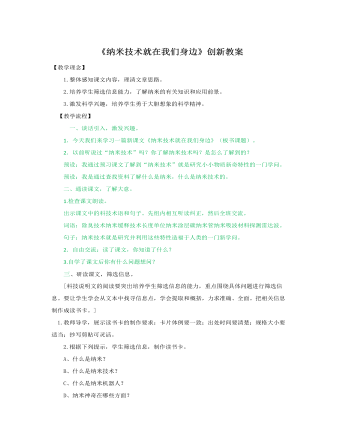
部编人教版四年级下册《 飞向蓝天的恐龙》创新教案
【教学理念】 1.整体感知课文内容,理清文章思路。2.培养学生筛选信息能力,了解纳米的有关知识和应用前景。3.激发科学兴趣,培养学生勇于大胆想象的科学精神。【教学流程】一、谈话引入,激发兴趣。1.今天我们来学习一篇新课文《纳米技术就在我们身边》(板书课题)。2.以前听说过“纳米技术”吗?你了解纳米技术吗?是怎么了解到的?预设:我通过预习课文了解到“纳米技术”就是研究小小物质新奇特性的一门学问。预设:我是通过查找资料了解什么是纳米,什么是纳米技术的。二、通读课文,了解大意。1.检查课文朗读。出示课文中的科技术语和句子。先组内相互听读纠正,然后全班交流。词语:除臭技术纳米缓释技术长度单位纳米涂层碳纳米管纳米吸波材料探测雷达波。句子:纳米技术就是研究并利用这些特性造福于人类的一门新学问。2.自由交流:读了课文,你知道了什么?3.自学了课文后你有什么问题想问?
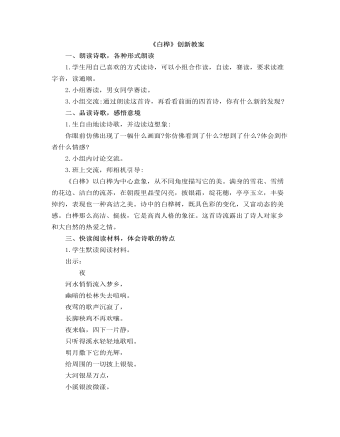
部编人教版四年级下册《白桦》创新教案
一、朗读诗歌,各种形式朗读1.学生用自己喜欢的方式读诗,可以小组合作读,自读,赛读,要求读准字音,读通顺。2.小组赛读,男女同学赛读。3.小组交流:通过朗读这首诗,再看看前面的四首诗,你有什么新的发现?二、品读诗歌,感悟意境1.生自由地读诗歌,并边读边想象:你眼前仿佛出现了一幅什么画面?你仿佛看到了什么?想到了什么?体会到作者什么情感?2.小组内讨论交流。3.班上交流,师相机引导:《白桦》以白桦为中心意象,从不同角度描写它的美。满身的雪花、雪绣的花边、洁白的流苏,在朝霞里晶莹闪亮,披银霜,绽花穗,亭亭玉立,丰姿绰约,表现也一种高洁之美。诗中的白桦树,既具色彩的变化,又富动态的美感。白桦那么高洁、挺拔,它是高尚人格的象征。这首诗流露出了诗人对家乡和大自然的热爱之情。
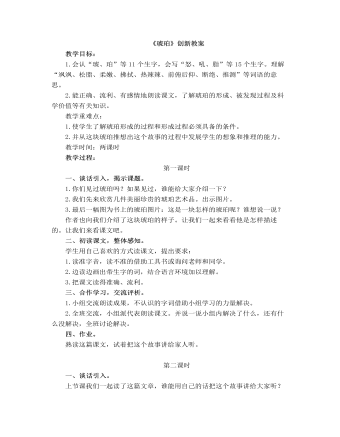
部编人教版四年级下册《琥珀》创新教案
教学重难点:1.使学生了解琥珀形成的过程和形成过程必须具备的条件。2.并从这块琥珀推想出这个故事的过程中发展学生的想象和推理的能力。教学时间:两课时教学过程:第一课时一、谈话引入,揭示课题。1.你们见过琥珀吗?如果见过,谁能给大家介绍一下?2.我们先来欣赏几件美丽珍贵的琥珀艺术品。出示图片。3.最后一幅图为书上的琥珀图片:这是一块怎样的琥珀呢?谁想说一说?作者也向我们介绍了这块琥珀的样子。让我们一起来看看他是怎样描述的。让我们来看课文吧。二、初读课文,整体感知。学生用自己喜欢的方式读课文,提出要求:1.读准字音,读不准的借助工具书或询问老师和同学。2.边读边画出带生字的词,结合语言环境加以理解。3.把课文读得准确、流利。
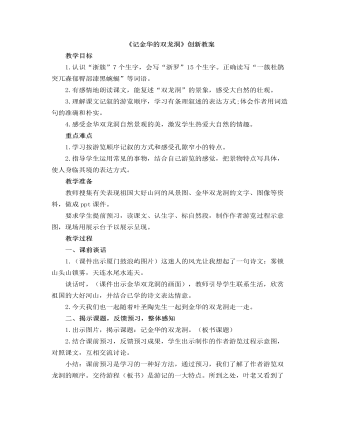
部编人教版四年级下册《记金华的双龙洞》创新教案
教学目标1.认识“浙簇”7个生字,会写“浙罗”15个生字。正确读写“一簇杜鹃突兀森郁臀部漆黑蜿蜒”等词语。2.有感情地朗读课文,能复述“双龙洞”的景象,感受大自然的壮观。3.理解课文记叙的游览顺序,学习有条理叙述的表达方式;体会作者用词造句的准确和朴实。4.感受金华双龙洞自然景观的美,激发学生热爱大自然的情趣。重点难点1.学习按游览顺序记叙的方式和感受孔隙窄小的特点。2.指导学生运用常见的事物,结合自己游览的感觉,把景物特点写具体,使人身临其境的表达方式。教学准备教师搜集有关表现祖国大好山河的风景图、金华双龙洞的文字、图像等资料,做成ppt课件。要求学生提前预习,读课文、认生字、标自然段,制作作者游览过程示意图,现场用展示台予以展示呈现。

部编人教版四年级下册《文言文二则》创新教案
三、教学过程(一)导入新课:1.师:同学们,中国是世界上历史最悠久的国家之一,在漫漫的历史长河中,产生了大量的神话传说和历史故事,后来人们把这些神话传说和历史故事加以锤炼,便形成了许多脍炙人口的成语。下面,让我们一起来感受下中华语言文化的精华,背诵下我们积累的成语。)2.学生起头,背诵成语接龙。(在今后的学习中我们还会积累更多的成语,希望同学们继续保持这种学习精神。)3.导入:成语是我国语言文化的精华,它们有的庄重严肃,有的机智幽默,而且大多数的成语背后都有一个生动的故事。今天老师给大家带来个有趣的成语故事,大家想不想看?这个成语故事的名字叫做“铁杵成针”。(板书课题:铁杵成针)不过,老师有个要求,希望同学们能带着这些问题认真去观看。
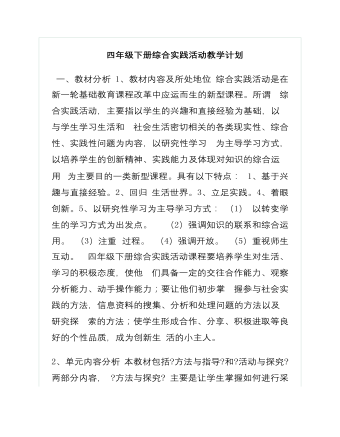
四年级下册综合实践活动教学计划及教案
一、教材分析 1、教材内容及所处地位综合实践活动是在新一轮基础教育课程改革中应运而生的新型课程。所谓综合实践活动,主要指以学生的兴趣和直接经验为基础,以与学生学习生活和社会生活密切相关的各类现实性、综合性、实践性问题为内容,以研究性学习为主导学习方式,以培养学生的创新精神、实践能力及体现对知识的综合运用为主要目的一类新型课程。具有以下特点: 1、基于兴趣与直接经验。2、回归生活世界。3、立足实践。4、着眼创新。5、以研究性学习为主导学习方式:(1)以转变学生的学习方式为出发点。(2)强调知识的联系和综合运用。(3)注重过程。(4)强调开放。(5)重视师生互动。四年级下册综合实践活动课程要培养学生对生活、学习的积极态度,使他们具备一定的交往合作能力、观察分析能力、动手操作能力;要让他们初步掌握参与社会实践的方法,信息资料的搜集、分析和处理问题的方法以及研究探索的方法;使学生形成合作、分享、积极进取等良好的个性品质,成为创新生活的小主人。2、单元内容分析本教材包括?方法与指导?和?活动与探究?两部分内容, ?方法与探究? 主要是让学生掌握如何进行采访,通过一系列活动,掌握采访的准备、注意事项、具体实施,及最后的交流总结,培养学生交往能力。 ?活动与探究?包括六个主题,主题一我们身边的标志,通过让学生认识标志,体会含义。学会分类,最后学会制作标志,循序渐进,蕴含了创新、守规、审美等能力的培养;主题二早餐与健康通过谈论,调查、分析讨论培养学生交流总结能力,树立健康生活意识;主题三,有趣的丝网花,通过制作培养学生合作、审美、动手能力;主题四巧手做风筝继续对学生进行培养;主题五植物的扦插与嫁接,与现实生活联系密切,通过活动掌握方法,体验快乐,体验劳动的乐趣;主题六争做小小志愿者,通过了解体验志愿者的活动,丰富阅历,培养学生的服务意识,自身获得提升与发展。教材的重点、难点:重点:学会交流,提升能力;认识各种标志,学会制作;学会健康的生活;通过制作丝网花、风筝、植物的扦插于嫁接,学会制作,提高动手能力,通过体验小小志愿者,提高服务意识。难点:教学中让学生亲身参与、主动实践,在实践中综合运用所学知识解决各种实际问题,提高解决实际问题的能力。学习基础:四年级学生已具备了一定的实践能力,因此要逐步培养学生一些探究问题的方法,提高学生的动手意识,能够从生活和学习中挖掘自己感兴趣的活动主题,能够试着和同学展开小组合作学习,在有效的活动中不断提高学生的动手与创新的潜能。
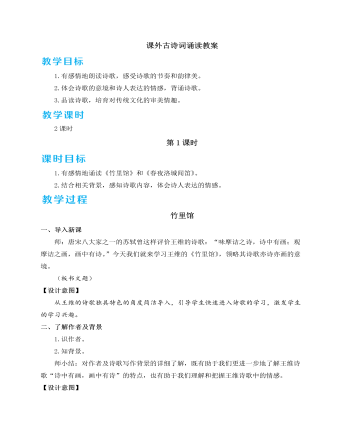
人教部编版七年级下册课外古诗词诵读教案
四、品读揣摩诗歌情志1.读出意境画面。师:请同学们以小组为单位,齐声朗读诗歌,然后合作交流,探究下面问题。(1)诗人用了哪些意象来表现晚春景色?诗人用了什么手法来写晚春景物?取得了怎样的艺术效果?(2)诗歌一、二句写出了怎样的晚春景致?请同学们用自己的语言描绘出来。(3)诗的三、四句意蕴深刻,为历代传诵。请从修辞手法的角度对这两句诗进行赏析。(生齐读后,小组交流、讨论问题,师指导明确)预设 (1)诗人用了草树、杨花、榆荚等意象表现晚春景色。一个“斗”字,运用拟人的修辞手法,把花朵人格化,形象生动地写出了晚春时节花草树木争芳斗艳的美丽景象。花草树木仿佛都有了情思,有了个性,成了精灵,使描绘的晚春景致生动而有情趣。

六年级体育下册教案
一、积极游戏乐活动 教师活动: 1、组织学生进行常规训练。 2、组织学生游戏活动,注意安全。 学生活动: 1、体育委员整队,检查出席人数。 2、指导学习向左转走队列要求。
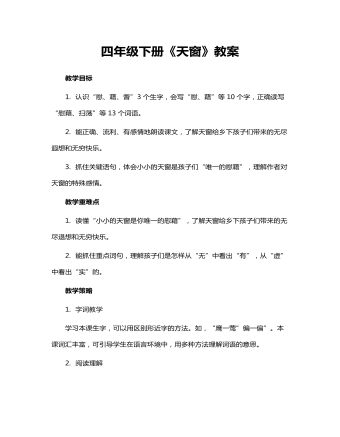
四年级下册《天窗》教案
教学目标1. 认识“慰、藉、瞥”3个生字,会写“慰、藉”等10个字,正确读写“慰藉、扫荡”等13个词语。2. 能正确、流利、有感情地朗读课文,了解天窗给乡下孩子们带来的无尽遐想和无穷快乐。3. 抓住关键语句,体会小小的天窗是孩子们“唯一的慰藉”,理解作者对天窗的特殊感情。教学重难点1. 读懂“小小的天窗是你唯一的慰藉”,了解天窗给乡下孩子们带来的无尽退想和无穷快乐。2. 能抓住重点词句,理解孩子们是怎样从“无”中看出“有”,从“虚”中看出“实”的。教学策略1. 字词教学学习本课生字,可以用区别形近字的方法。如,“鹰一莺”编一偏”。本课词汇丰富,可引导学生在语言环境中,用多种方法理解词语的意思。2. 阅读理解主要采用提出问题引导阅读的方式教学:先让学生带着疑问读课文,接着细读课文并思考天窗给乡下的孩子带来了什么,然后抓住文章的中心句“小小的天窗是你唯一的慰藉”一句理解课文,最后结合全文内容体会孩子被唤回家时的失落,又从天窗中想象出无穷的情形、故事,找回了失去的快乐。3. 表达运用运用读写结合的策略,学习课文后,启发学生结合自己的生活实际谈感受,写感受。教学准备1. 预习提纲:完成《状元大课堂·好学案》对应课文预习作业。2. 准备资料:多媒体课件。教学课时:2课时第1课时,课时目标:1. 认识“慰、藉、瞥”3个生字,会写“慰、藉”等10个字,正确读写“慰藉、扫荡”等13个词语。2. 能正确、流利地朗读课文,整体感知课文主要内容,理清课文脉络。教学过程板块一,设疑激趣,导入新课。1. 导入新课。(1) 课件出示天窗图片。(2) 师引导:同学们,你们知道这是什么吗?(3) 了解课文题目。师板书课题:天窗;指名读课题。(4) 设置疑问。师引导:看到课题,同学们有什么想问的吗?(示例:什么是天窗?)

人教版新目标初中英语七年级下册Where is your pen pal from教案
2.1Match the country with the language.Step II Reading3a? let the students read the letter fast and answer the questions.? Let the students ask more questions about the letter as possible as the can.Step III Writing3b.Step IV. Pairwork2cStep V Listening2a, 2bStep V. HomeworkExercises book(1) P3Exercises book (2) P3Period FourStep I . Dictate the words and sentences in Unit1.Step II. Self-checkStep III. Check the answers for Exercises book in the unit.Step IV. Home workRevise and preparation for unit 2.教学反思:通过本单元的学习,学生基本可以谈论人们的国籍,居住城市及其所说的语言,通过书信方式去介绍自己并寻找笔友。但在涉及到国外的一些城市时,学生对这方面的知识相对欠缺,能介绍的城市并不多,也反应出学生课前预习不充分,这跟学生学习条件也有关,大多数学生无法通过网络获取所需信息。因此,在以后的教学中要多指导学生通过计算机网络获取信息,拓宽知识面。

人教版新目标初中英语八年级下册Why don’t you get her a scarf教案
教师带领学生复习有关描述宠物的词汇,采用教师提问学生回答的方进行。如:T:What animals do you think would be good pets?What animals do you think would be bad pets?What do you think are good animals for a six-year-old child?然后学生进行 pairwork 练习。Task two: 师生互动,学习探究 1、播放3a部分的录音,引导学生一边听录音,一边跟读。2、通过听录音学生回答以下问题:Why do you think pot-bellied pigs are popular?What are the advantages and disadvantages of keeping such a pet?教师对学生的回答进行及时点评。3.学习范文,学习重点短语,为下步的模仿写作提供语言素材。T :1. )Have you ever kept a pig as a pet?Do you like pigs? St.:No.…Why don’t you like to keep a pig? St: No.They’re too dirty and lazy(Do you know in some foreign countries like Hollyland, Australia,pigs are the most popular pet.there’s a kind of pig.(图)it has an interesting name? it ‘s called a pot-bellied pig.) Now,let’s learn an article about this kind of interesting pet.2.)play the tapeSt.:Listen and repeat3.)show some Qs on computer(本子St.: read silently,then answerthe Qs(本子)4.)Ask ss. Close book and retell this passage.(what is a pot-bellied pig? Is it a good or bad pet? ) St.: retell it to each other“A pot –bellied pig is a popular pet now…”5.read the article together.St.:.practice reading

人教版新目标初中英语八年级下册Would you mind turning down the music教案
Step 4. Group work (4)1. Ask a pair of students to read the dialogue. Say, This activity provides speaking, listening and writing practice using the target language.2. Ask students to complete the work in groups.3. Check the answers with the whole class. 4. Explain some of the language points. Step 5. Word review (Self check 1)1. Ask students to read the words and the phrases given. 2. Fill in the blanks with proper forms of these words to complete the sentences. 3. Check the answers with the whole class. Homework:Do activity 2 on page 57 after class. Period 6Teaching aims: 1. Teach vocabulary words and the useful expressions. 2. Enable the students to learn etiquette in different culture. 3. Help the students learn how to behave politely in public places and in daily life. Teaching procedures:Step 1. RevisionHelp students to review the function of making requests through a free talk. Then lead them to the topic of etiquette. Explain the meaning of etiquette. Or, ask students to look it up in the dictionary. Step 2. Pre-reading (Section 1)1. Ask students to read the picture and make a list with their partner about how many rules of etiquette can be seen being broken.

人教版新目标初中英语九年级下册I’ll help clean up the city parks教案
Talk about offering help (P60)I’ll help clean up the city parks.A: I’d like to work ...B: You could help ...Talk about ways to tell people about the Clean-Up Day (P61)We need to ...We can’t ...I’ll ...Talk about the work the volunteers do (P62)These three students all volunteer their time to help other people.Somebody loves to ... / helps ... / plans to ... / wants to ...A: What do you like doing?B: I like ... A: What kind of volunteer work do you think I could do?B: You could ...1. 重点词汇advertisement, fix, repair, pleasure, blind, deaf, shut, carry, specially, fetch2. 认读词汇hunger, homeless, cheer, clean-up, sign, establish, major, commitment, elementary, veterinarian, coach, similar, call-in, strategy, disabled, organization, unable, support, appreciate, donation, part of speech, pronoun, adverb, preposition, conjunction, donate, Jimmy, Sally3. 词组clean up, cheer up, give out, put off, set up, think up, take after, fix up, give away, put up, hand out, work out, at once

人教版新目标初中英语七年级下册I ’d like some noodles教案
教学过程Step 1: warming-up Sing a song---------“food and drink” Step 2: Revision1 Dictation2 Revise: What kind of noodles would you like?I’d like …What size bowl of noodles would you like?I’d like…Step 3: Presentation1 show pictures of food, ask students say the words.2 Students read the newspaper ad in 3a. Fill in blanks with words in the box. Then read the ad together, the teacher explains some difficult language points.3 Check the answers Step 4 PracticeAsk students to finish 3b in the same way according to 3a. Students read the short passage and fill in the blanks .At last, check the answers.Step 5 productionAsk students to write their own ad for dumplings, noodles, drinks, and other foods they know. Then ask students to read their partner’s ad. Then order food and drink from their partner.Step 6 Home workGroup work – make an ad about “food and drink”

人教版新目标初中英语七年级下册What do you think of game shows教案
五、教学Section B-2c1. Pair work: What do you think of the belt/sunglasses/…? What does your father/mother/… think of your scarf/belt…?2. Group work(1). Teacher shows some different kinds of school uniforms (制服)and asks : “ What do you think of your school uniforms? If you have a chance to choose your school uniforms, what kind would you like to choose?”(2). Discuss in groups.(3).Get some Ss to report in class.说明:这一步旨在让学生运用已有的语言知识谈论对事物的看法和意见,并简单阐明理由,培养学生的主动思维能力和运用英语的能力。六、教学拓展调查电视节目的收视率任务:调查你周围的人对现在各种电视节目的反响。活动过程:1.教师布置任务,让学生调查周围的人(包括他的亲戚朋友和邻居)喜欢收看哪方面的电视节目。2.学生进行调查活动,运用本单元所学的句型What do you think of….? (Why?)What's your favorite game shows?What do you think of talk show?I doesn’t mind it.I like it.I love it.I can’t stand it.3.记录下排在前10位的TV Program,填写调查表,比较其收视率。

人教版新目标初中英语七年级下册Where did you go on vacation教案
句型: Where did you go on vacation? I went to summer camp.Did she go to Central Park?Yes,she did.No, she didn’t语法:一般过去时特殊疑问句、一般疑问句及肯、否定回答。课时安排4课时第一课时:Section A:la,1b,lc,2a,2b,2c 第二课时:Section A:3a,3b,4第三课时:Section B:1,2a,2b,2c第四课时:Section B:3a,3b,3c,4 and Self Check第一课时教学目标掌握描写假期生活的形容词。假期里自己所做事情的简单表达。谈论假期做的事情及当时情况。谈论假期时旅游的天气,旅游者以及食物等。教学过程一、导入播放一首英文歌曲:Let’s travel 说明:通过让学生听节奏欢快迪斯尼英语歌曲Let’s travel.引入本节课谈论的话题vacation and travel. 让歌曲使学生的思维活跃,增强课堂气氛,激发学生提高学习英语的兴趣。T:How is the trip ?Ss : It’s pretty good/ happy/exciting /relaxing/busy/dangerous/ fantastic说明:这个问题是为了操练形容词。建议让多个Ss作答。鼓励他们用不同的形容词。上述个别形容词本应在第二课时中出现,但可以在warming-up中第一次非正式出现。这些形容词也可在老师的评价语中适时出现,以加深学生对词汇的印象。

人教版新目标初中英语八年级下册Have you ever been to an amusement park教案
(1)Have you ever been to …? Yes, I have. / Yes, I have ever been to …No, I haven’t. / No, I have never been to …(2)When did you go there? I went there last year. (3)I have never been to a water park. Neither have I. I have ever been to an amusement park. So have I. (4)How long have you been studying English? I’ve been studying English since nine o’clock. I’ve been studying English since I came back home. I’ve been studying English for five hours. (5)What’s that? It’s an amusement park in Japan. I’ve never been to an amusement park like it before. It’s fun to learn another language. Let’s go tonight. Isn’t this great?space museum, amusement park, water park, South America, Peru, Holland, European culture, tour guide, flight attendant, musical instrument, more than, be from, get to, take lessons, neither, discover, graduate, change

人教版新目标初中英语九年级下册By the time I got outside, the bus had already left教案
Ⅰ. Teaching Aims and Demands1. Knowledge Objects(1) Key Vocabularyoversleep(2) Target LanguageWhat happened?I overslept. And by the time I got up, my brother had already gotten in the shower.2. Ability Objects(1) Teach the students to use the new words.(2) Train the students to narrate past events with the Past Perfect Tense.(3) Train the students' listening and speaking skills with the target language.3. Moral ObjectIt’s a good habit to go to bed early in the evening and get up early in the morning. So you’ll never be in a hurry in the morning.Ⅱ. Teaching Key Points1. Key Vocabularyoversleep2. Target LanguageNarrate past events with the Past Perfect TenseⅢ. Teaching Difficult Points1. Train the students to narrate past events with the Past Perfect Tense.2. Train the students to understand the target language in spoken conversation.Ⅳ. Teaching Methods1. Thinking of examples from the students' real lives.2. Making sentences by looking at the pictures.Ⅴ. Teaching AidA tape recorderⅥ. Teaching ProceduresStep I Revision1. Revise the language points in Unit 8.Ask some questions like this: What volunteer work would you like to do?Help the students to answer, I’d like to…/I love to…/I hope to2. Practice the dialogue in Activity 3c on page 62 again. Get students to role play the similar dialogues with the following.

人教版新目标初中英语九年级下册Rainy days make me sad教案
1. 教材分析本单元以how do things affect you?为话题, 从颜色、天气、音乐、广告、产品等方面谈论了外界事物如何影响人的心情。要求学生掌握表达某物或某事给人带来的感觉、看法或影响等。共设计了四个部分的内容:Section A 该部分有4个模块:第一模块围绕Which restaurant would you like to go to?这一话题展开思维(1a)、听力(1b)、口语(1c)训练;第二模块围绕How does music affect you? 进行听力(2a-2b)、口语训练(2c);第三模块继续围绕how do colors in the restaurant affect you这一话题展开训练,训练形式为阅读和问题体验(3a)和小组活动(3b);第四模块仍就How do things affect you这一话题以调查的形式展开讨论。Section B该部分有4个模块:第一模块围绕产品广告对人们的影响这一话题以“配对”(1a)与“列举”(1b)两种形式展开训练;第二模块继续围绕How do things affect you? 进行听力(2a-2b)、口语对话训练(2c);第三模块围绕“Advertising”这一话题展开阅读(3a-3b)和写作(3c)训练;第四模块围绕How posters affect you这一话题以口语训练形式展开小组活动。

人教版新目标初中英语九年级下册Could you please tell me where the restrooms are教案
Step Ⅰ RevisionCheck homework. Ask a few students to read the article in 3a.Then ask a few students to read their guides.Step Ⅱ Part 1Look at the words in the box. Ask a student to read them. Make sure the students understand the meaning of the words. You are to fill in the blanks with the words. In some cases, students may need to use another form of the word, for example adjusting for tense or subject/ verb agreement.Ask students to fill in the blanks on their own.Check the answers. Step ⅢPart 2Go through the instructions with the class.Look at the example with the students.Ask students what the answer would be.Ask a student to read the question and answer it.Excuse me, could you tell me where the bank is, please?The bank is across the street from the shopping malt.Get students to complete the work in pairs.Check the answers. Ask a few students to read their questions.Step Ⅳ Just for Fun!Ask all the students to read the conversation. Ask: What is funny about this cartoon? Help students to explain. A Martian is a person from the planet Mars.There is no such thing as Martian food on Earth, and the clerk looks silly because he is trying to think of where there is a Martian restaurant.Invite some pairs of students to present this conversation to the rest of the class.Step Ⅴ Summary and HomeworkIn this class, we’ve done much writing practice using the key vocabulary words and the target language presented in this unit. After class, please finish the questions in 2 in your exercise books. Then finish the exercises on pages 47~48 of the workbook as well.The Seventh Period Ⅰ Teaching Aims and Demands1. Knowledge Objects(1) Key Vocabularyimage, adventure, jealousy, hero, crime, journey, brave, no longer, show interest in, take it easy, become interested in, plain looks(2)Text:Grown-ups like cartoons, too.2. Ability Objects(1) Fast-reading to get a general idea of the text.(2) Careful-reading to get the detailed information in the text.


